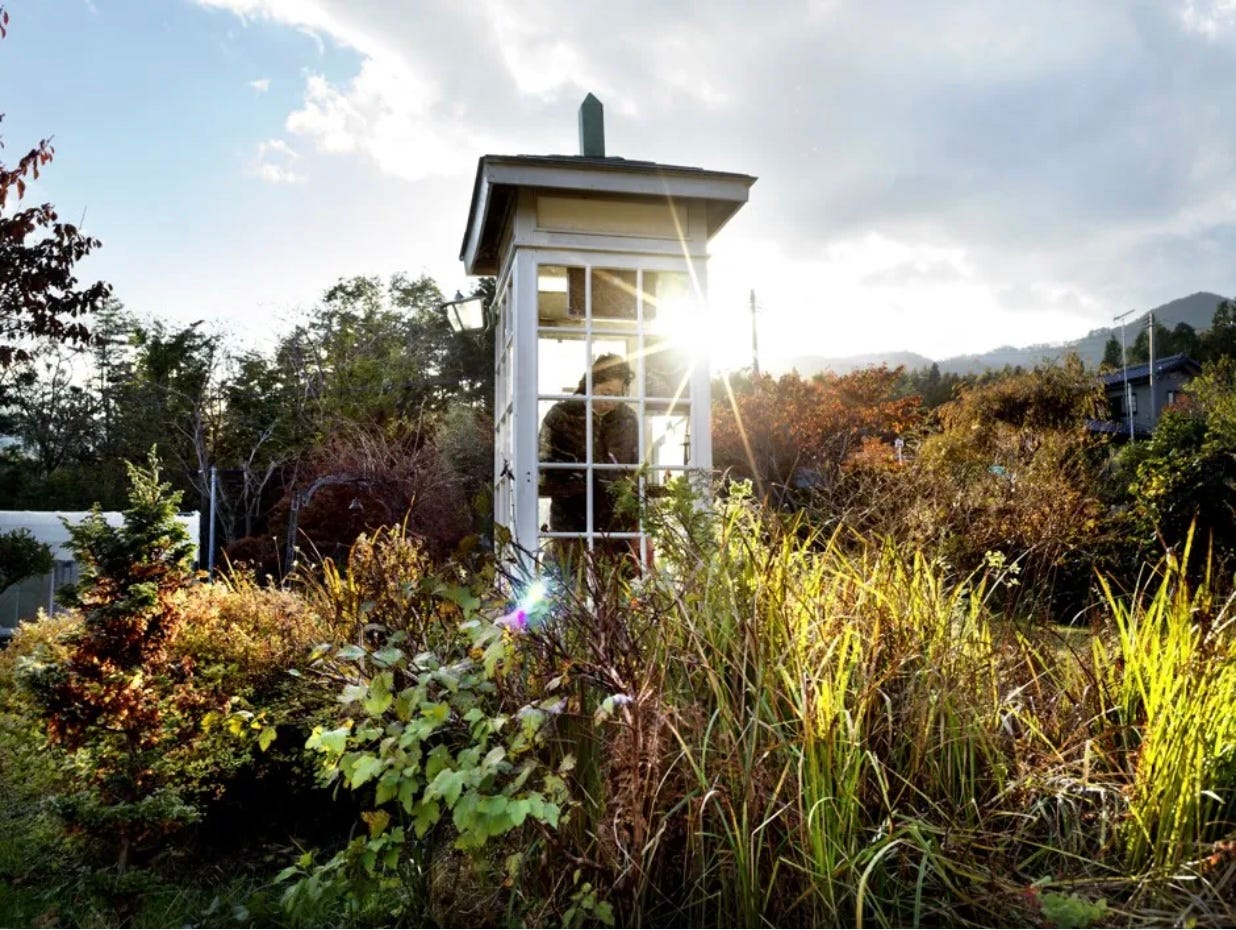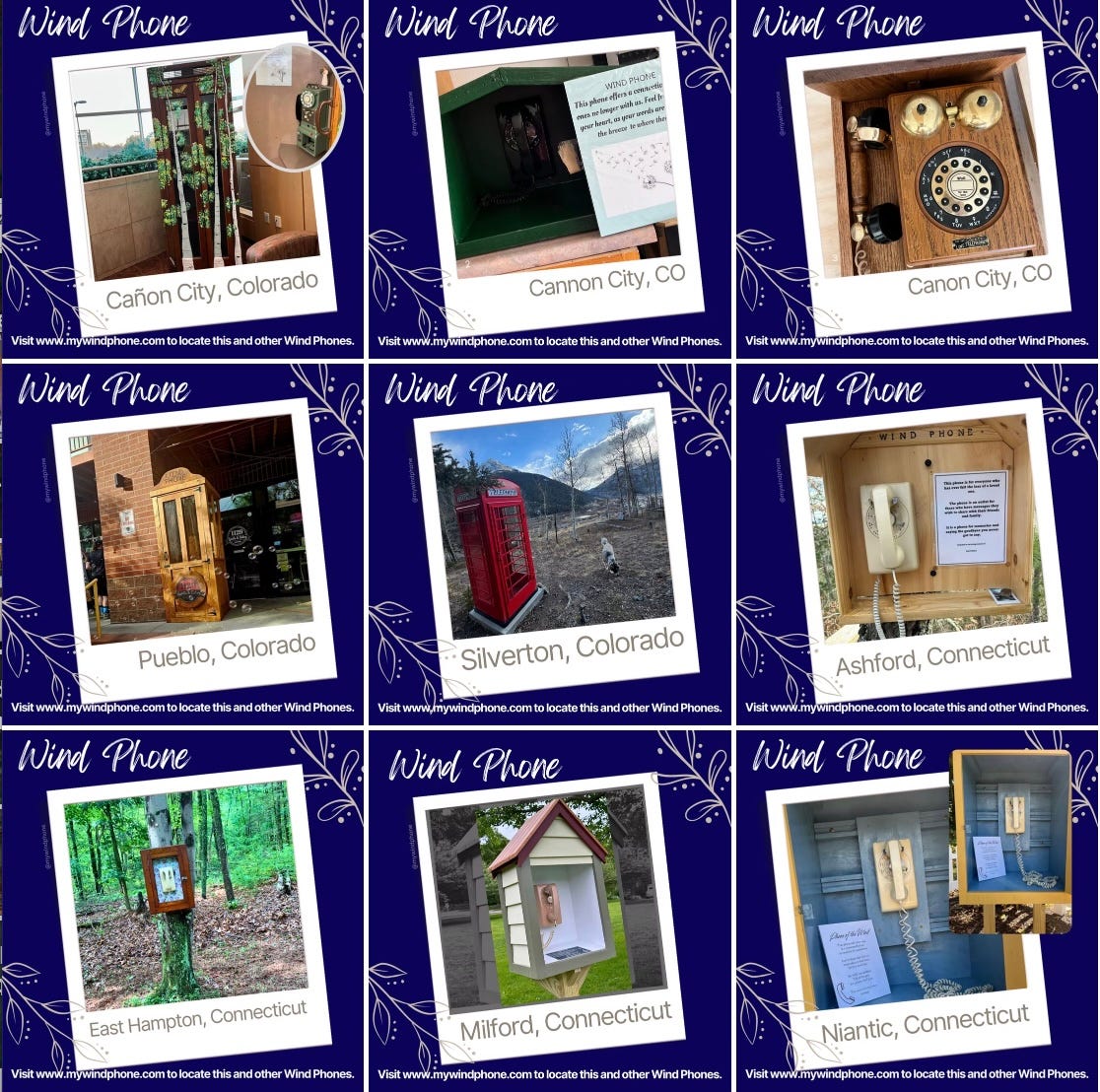The Quantum Telecommunications Network of Grief
Wind Phones, Einstein, and Talking to the Dead
Tucked among the rock towers and skeletal creosote of Joshua Tree, California, you might stumble across something strange and tender. From a distance, it’s just a dark silhouette against sand the color of old bone. But walk closer and you’ll see it’s a kind of altar to connection: a weatherworn wooden chair pulled up beside a boxy piece of furniture that looks half Victorian dresser, half high school science exhibit. Inside the open glass case on the top, something winks in the desert glare: a canary-yellow rotary phone. The kind that conflated numbers and time, each 0 dilating the moments a bit wider. There are no telephone poles here, no utility lines to explain its function. The only wire is the rubberized pigtail cord connecting the handset to the base. But despite being wildly out of place, this makeshift phone booth is not a mirage. It’s a “Wind Phone” constructed by writer Colin Campbell and his wife, Gail Lerner.
In June of 2019, Campbell and his family were en route to their Joshua Tree vacation home when their car was struck by a drunk driver, killing 17-year-old daughter Ruby and 14-year-old son Hart. In the wreckage of that grief, Campbell and Lerner created a tiny, desert sanctuary for holding conversations across the vast stretches of the unknown. A couple weeks ago, Campbell posted a picture of the Wind Phone with the caption: “We made a Wind Phone in Joshua Tree in honor of Ruby and Hart! Anyone in grief can visit, sit down in the privacy of the vast desert, pick up the rotary phone and call their loved one via the cosmic connection.” He included coordinates: 34.122889, -116.266333.
The first Wind Phone was constructed in 2010 by Japanese garden designer, Itaru Sasaki. Mourning the death of his cousin, he placed a white, glass-paned telephone booth in his garden. “Because my thoughts couldn’t be relayed over a regular phone line,” he said in an interview, “I wanted them to be carried on the wind.” The following year, when the Tōhoku earthquake and tsunamis killed a tenth of the people in his town, Sasaki opened his phone booth to the public. Since then, over 30,000 people have passed through the gate of his iris-spangled garden to speak into that unconnected receiver.

Who among us doesn’t wish they could dial a number your fingers still know in their muscle fibers? Who doesn’t have something unsaid – a private term of endearment, a stagnant apology, a joke no one else would understand – pacing beneath their tongue? As a result, hundreds of Wind Phones have emerged across the globe. Turns out there’s a Wind Phone less than a 15-minute drive from my house. I haven’t been yet, but I would probably call my mother’s mother first on a number I haven’t dialed in 30 years but still use as my loyalty number at the grocery store. Just so I have an excuse to trace the familiar pattern.
Einstein often used the telephone as an example to demonstrate the logical flaws in the Newtonian idea of absolute time, to show how events perceived as simultaneous from one perspective may not be from another. In his lecture Ether and the Theory of Relativity delivered at the University of Leiden in May of 1920, he described how a conversation between two people, one in Berlin and one in Paris, cannot be said to happen in a shared moment. “The simultaneity of the two events—the speaking and the hearing—has no meaning in itself. It depends on the state of motion of the observer who is judging.”

If it takes time for sound to travel, and even more time for an electric signal to cross wires, then our perception of the present varies. There is no shared moment that two people, distant from one another, can access. It could feel existentially lonely, knowing that we each inhabit a private “now,” separate as stars. But later in his career, Einstein uncovered something very different, something that vexed him: the strange mischief of quantum entanglement.
He theorized that two or more particles can become so intrinsically linked that the state of one instantly determines the state of the other, even when separated by vast distances. He famously disliked the paradox and the way it violated his theories on local realism, calling it “spukhafte Fernwirkung” or “spooky action at a distance.”
Campbell’s phone is just the latest of an international list that keeps growing. Maybe Wind Phones make symbolic sense in an almost Jungian way that we understand in our marrow. Or perhaps, as the world is increasingly stripped of its rituals around grief, a space dedicated to speaking with those we’ve lost feels sanctified. I wonder, though, if more Wind Phones keep appearing like an ethereal telecommunications network because something in us already understands what physics only hints at: that we forge connections more enduring than death. That time isn’t as linear as we pretend it is. If our rotary phones, and now our smartphones, are subject to relativity, maybe Wind Phones are the quantum party line of the spirit. The phone that connects us to those whose spin forever changes our spin needs no wires, no dial tone.
One of Einstein’s best friends of over 50 years was Swiss-Italian engineer, Michele Besso. They met as students in the late 1890s and grew closer in the 1900s when they would stroll home together after work at the Swiss federal patent office in Bern. Einstein named Besso as his only acknowledged collaborator on the four groundbreaking papers that laid the foundation for his theory of special relativity, thanking him for his ideas and steadfast conversation.
When Besso died in March of 1955, only weeks before Einstein’s own death at the age of 76, the famous physicist wrote to his best friend’s bereaved family: “Now he has again preceded me a little in parting from this strange world. This has no importance. For people like us who believe in physics, the separation between past, present, and future has only the importance of an admittedly tenacious illusion.”








Absolutely gorgeous. ❤️
Besso kinda a hottie